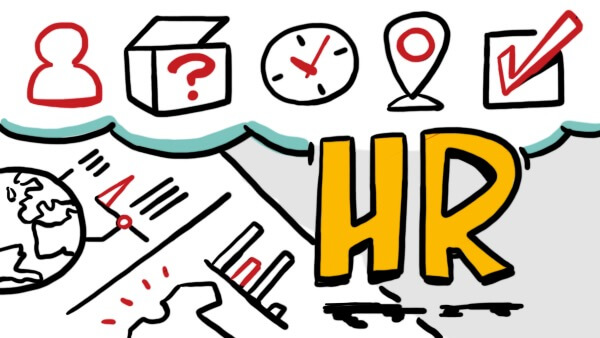The 5 W’s
Infographics – those beautiful, data-full hybrids of design and details. You might be familiar with infographics as part of your content marketing strategy, or as an innovative way to steer traffic to your website. But part of the beauty of an infographic is in its versatility. Infographics shouldn’t be relegated solely to the marketing team.
Most departments could benefit from a succinct and appealing way to share important information. And that includes the Human Resources department.
Read on for our simple rundown of using infographics for your HR content. We’re going to give you the who, what, when, where and why you need to introduce visual storytelling (specifically in infographic form) as part of your Human Resources arsenal.
Who?
There’s an appropriate application for an infographic for literally anyone who interacts with Human Resources. Think of this as similar to the sales funnel, but replace prospective customers with prospective employees.
At each point in the HR funnel, there is a person who could use an infographic.
Prospective employees benefit from an infographic detailing top ten reasons they should work at your company.
Onboarding employees could rely upon a variety of infographics:
- an overview of benefits,
- a visualization of company culture,
- a map of the various platforms they’ll need to learn to do their job well.
Existing employees might appreciate a flowchart posted in the cafeteria showing how to properly dispose of various forms of waste, or a visual representation of their goals and KPIs.
And even retiring or former employees can use infographics when they want a quick way to grab data to help refer people your way or to encapsulate what your business is all about.
What?
Put simply, what exactly is an infographic?
It’s information (usually lots of information), conveyed via digestible imagery (usually super eye-catching imagery). But (as you may have already gathered from some of our other posts on this topic), an infographic can be so much more than a single image to scroll through.
For the purposes of Human Resources, you’ll probably want to develop infographics that can go big. For example, large format posters to put up around your offices or common areas. That approach is a great way to serve a high volume of information to a high volume of employees at a glance as they pass by.
Infographics also make great takeaways, You can up your “curb appeal” at your next job fair or employee wellness event by handing out an infographic printed on a magnet or mousepad.
Regarding what data is best conveyed in infographic form, check out these fantastic examples of infographics used in HR. Give your team ideas on how to be more effective, more engaged, or more strategic by visually mapping it out for them. Showcase statistics on how the company is performing. Illustrate the onboarding process step by step.
As it turns out, when it comes to what can be conveyed via an infographic, the answer is “pretty much anything.”
When?
Based on what you’ve read so far, you might presume that the answer to when to use an infographic in HR is “any time!” And that is somewhat true. But it’s probably most effective to leverage the power of visual storytelling when it’s going to really make an impact.
Convert a data-heavy presentation or extensive email to a single infographic, and you’ll gain more attention, and more adoption, than you would if you sent out pages of content to pore over. And use infographics when you want to maximize the memorability of what you’re communicating.
Studies have shown that by adding images to words, the human brain is exponentially more likely to retain the information. Sometimes by over 65%!
Finally, for HR, turn to infographics whenever you sense that you need help engaging your employees. The more employees disengage, the more likely they are to start looking for new (engaging) work elsewhere. In fact, 56% of employees who consider themselves somewhat disengaged, and 73% of employees who’d say their actively disengaged are already looking.
Since visual communication leads to higher engagement, infographics can become a trusted tool. They can help keep your employees motivated, committed and invested in what your department and your company is doing.
Where?
Infographics are eminently shareable and great infographics often end up printed out and posted. So aside from sending out an HR infographic in an email, consider adding it to your company’s social channel.
Leverage infographics as part of your recruitment strategy on LinkedIn – posts with images boast 98% more comments on LinkedIn.
And use the infographic posters we mentioned previously to grab attention where it’s most pertinent. For instance, an infographic poster showing what’s recyclable vs. what needs to be tossed in the trash is a great visual reference for your employee cafeteria.
An infographic that illustrates your company’s policies and procedures could hang in the break room.
And perhaps infographics on more sensitive HR content like harassment or incident reporting could be sent out via email, so employees still have the option to reply to a person one on one.
Why?
There are a ton of aesthetic and emotional reasons to add infographics to your HR content. But stats and science are also on your side.
On average, people only read 28% of the words they see when they visit a web page. And even a complex image takes far less time to comprehend than a long read on a topic. Every HR department is tasked with disseminating lots of information speedily and effectively. When you need to convey important information to a large group of people in a quick and easy manner, an infographic is a perfect method.
As with any infographics, but perhaps of special importance to those created by or for Human Resources, be sure to follow best practices when you create your infographic. Fact check your data. Cite your sources. And keep your target audience top of mind.

